MKG 701 Marketing Plan: Fantong Restaurant Marketing Strategy
VerifiedAdded on 2022/11/14
|21
|5108
|268
Report
AI Summary
This marketing plan report presents a comprehensive analysis for Fantong Restaurant, a proposed Chinese restaurant in Leichhardt. It begins with an executive summary and introduction, followed by an in-depth examination of the company and industry background, including its mission and values. A thorough situation analysis assesses the internal, customer, and external environments, leading to a SWOT analysis that identifies strengths, weaknesses, opportunities, and threats. The plan outlines marketing goals and objectives, targeting both primary and secondary markets, and details product, pricing, distribution, and integrated marketing communication strategies. A financial analysis is included, along with marketing implementation and evaluation and control processes, all supported by references and appendices. The plan aims to establish Fantong Restaurant as a successful business in a competitive market.
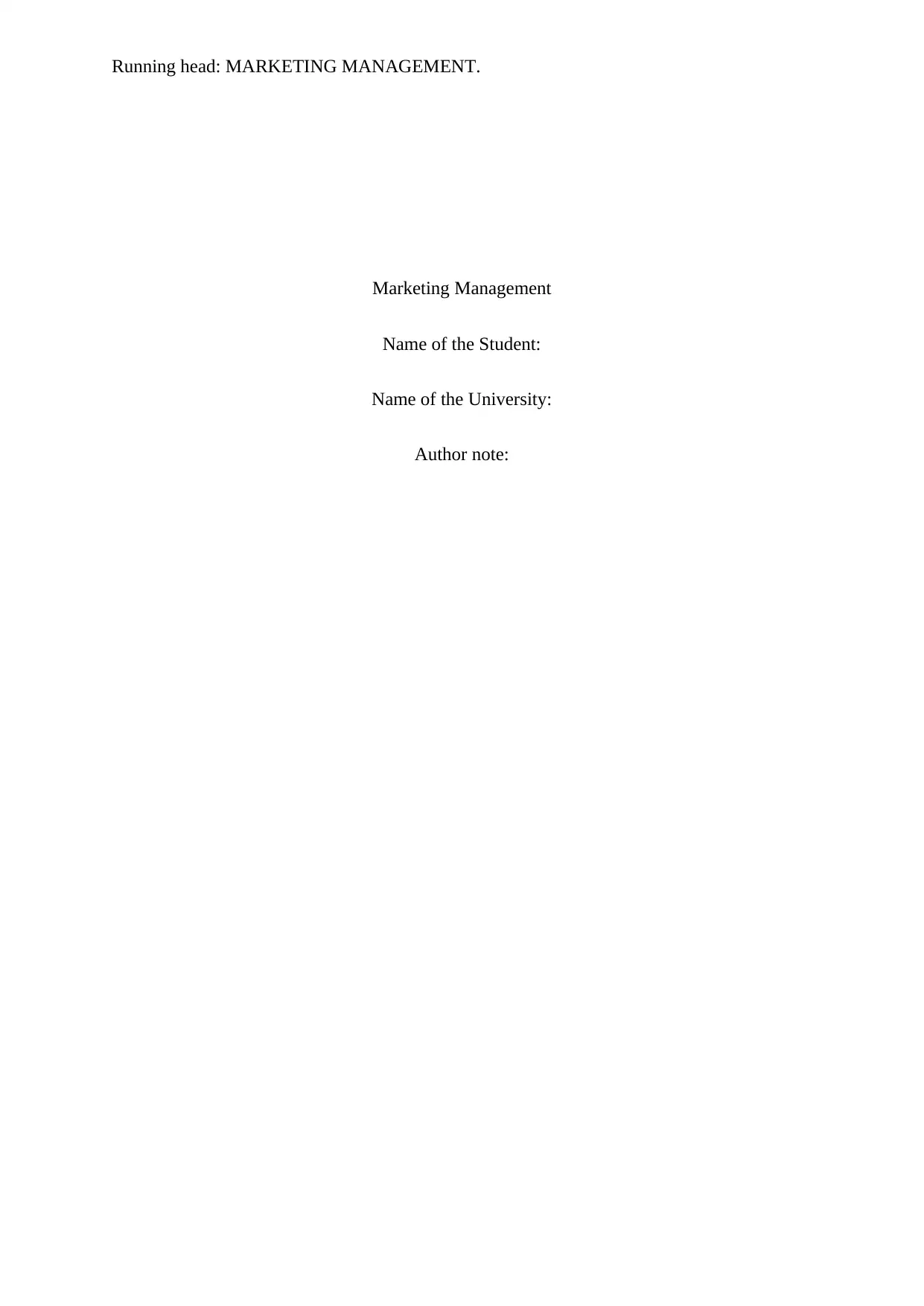
Running head: MARKETING MANAGEMENT.
Marketing Management
Name of the Student:
Name of the University:
Author note:
Marketing Management
Name of the Student:
Name of the University:
Author note:
Paraphrase This Document
Need a fresh take? Get an instant paraphrase of this document with our AI Paraphraser
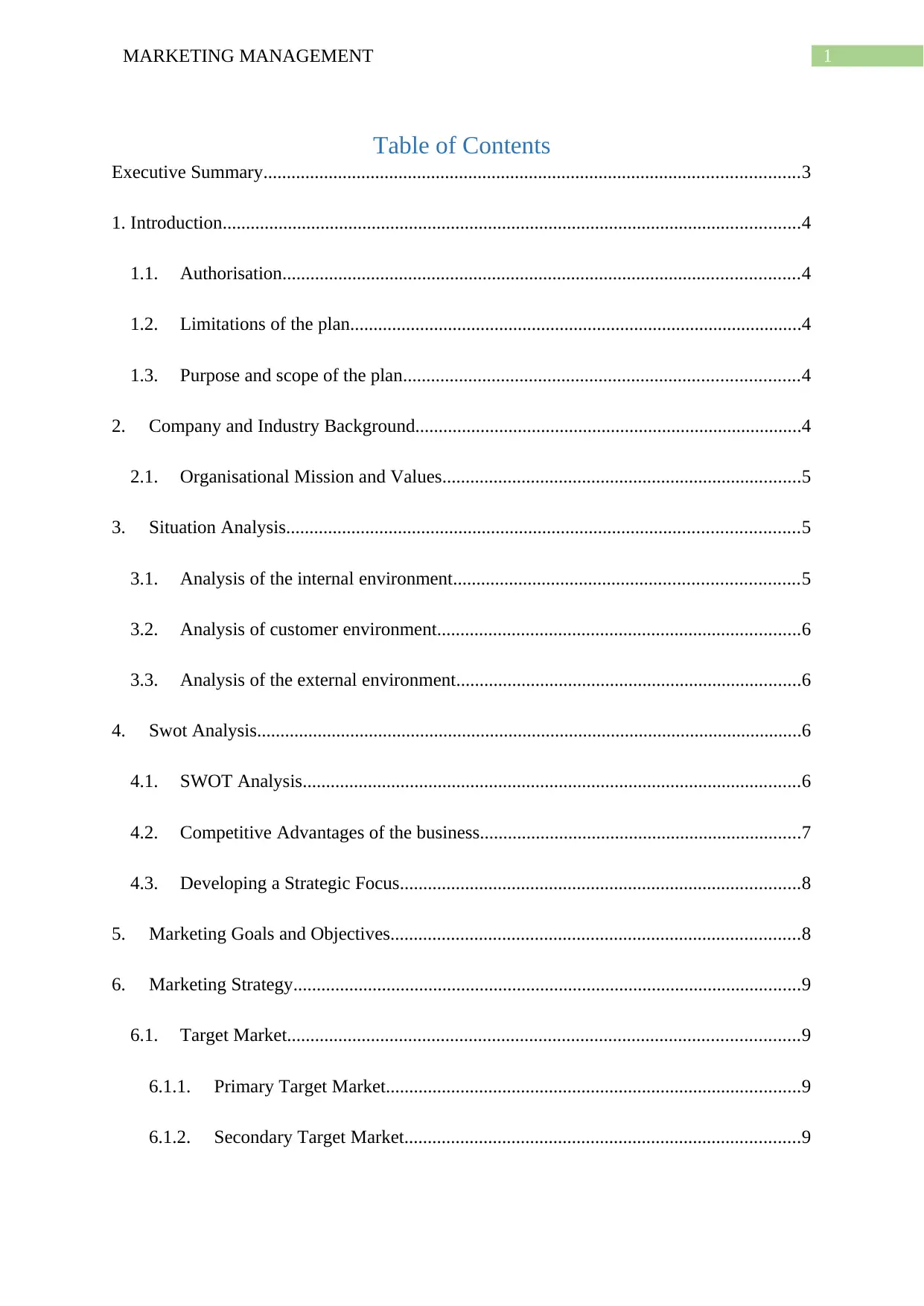
1MARKETING MANAGEMENT
Table of Contents
Executive Summary...................................................................................................................3
1. Introduction............................................................................................................................4
1.1. Authorisation...............................................................................................................4
1.2. Limitations of the plan.................................................................................................4
1.3. Purpose and scope of the plan.....................................................................................4
2. Company and Industry Background...................................................................................4
2.1. Organisational Mission and Values.............................................................................5
3. Situation Analysis..............................................................................................................5
3.1. Analysis of the internal environment..........................................................................5
3.2. Analysis of customer environment..............................................................................6
3.3. Analysis of the external environment..........................................................................6
4. Swot Analysis.....................................................................................................................6
4.1. SWOT Analysis...........................................................................................................6
4.2. Competitive Advantages of the business.....................................................................7
4.3. Developing a Strategic Focus......................................................................................8
5. Marketing Goals and Objectives........................................................................................8
6. Marketing Strategy.............................................................................................................9
6.1. Target Market..............................................................................................................9
6.1.1. Primary Target Market.........................................................................................9
6.1.2. Secondary Target Market.....................................................................................9
Table of Contents
Executive Summary...................................................................................................................3
1. Introduction............................................................................................................................4
1.1. Authorisation...............................................................................................................4
1.2. Limitations of the plan.................................................................................................4
1.3. Purpose and scope of the plan.....................................................................................4
2. Company and Industry Background...................................................................................4
2.1. Organisational Mission and Values.............................................................................5
3. Situation Analysis..............................................................................................................5
3.1. Analysis of the internal environment..........................................................................5
3.2. Analysis of customer environment..............................................................................6
3.3. Analysis of the external environment..........................................................................6
4. Swot Analysis.....................................................................................................................6
4.1. SWOT Analysis...........................................................................................................6
4.2. Competitive Advantages of the business.....................................................................7
4.3. Developing a Strategic Focus......................................................................................8
5. Marketing Goals and Objectives........................................................................................8
6. Marketing Strategy.............................................................................................................9
6.1. Target Market..............................................................................................................9
6.1.1. Primary Target Market.........................................................................................9
6.1.2. Secondary Target Market.....................................................................................9
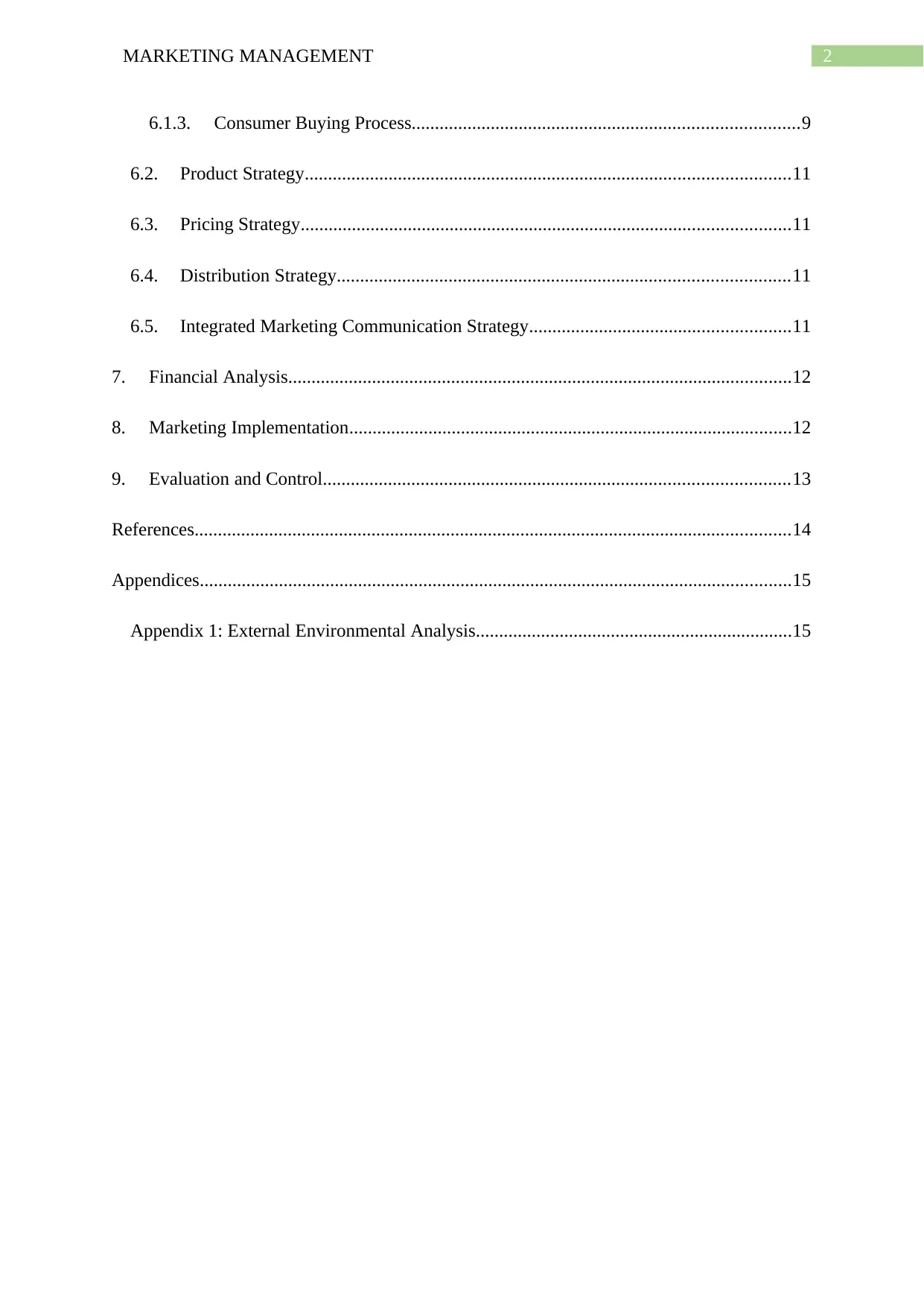
2MARKETING MANAGEMENT
6.1.3. Consumer Buying Process...................................................................................9
6.2. Product Strategy........................................................................................................11
6.3. Pricing Strategy.........................................................................................................11
6.4. Distribution Strategy.................................................................................................11
6.5. Integrated Marketing Communication Strategy........................................................11
7. Financial Analysis............................................................................................................12
8. Marketing Implementation...............................................................................................12
9. Evaluation and Control....................................................................................................13
References................................................................................................................................14
Appendices...............................................................................................................................15
Appendix 1: External Environmental Analysis....................................................................15
6.1.3. Consumer Buying Process...................................................................................9
6.2. Product Strategy........................................................................................................11
6.3. Pricing Strategy.........................................................................................................11
6.4. Distribution Strategy.................................................................................................11
6.5. Integrated Marketing Communication Strategy........................................................11
7. Financial Analysis............................................................................................................12
8. Marketing Implementation...............................................................................................12
9. Evaluation and Control....................................................................................................13
References................................................................................................................................14
Appendices...............................................................................................................................15
Appendix 1: External Environmental Analysis....................................................................15
⊘ This is a preview!⊘
Do you want full access?
Subscribe today to unlock all pages.

Trusted by 1+ million students worldwide
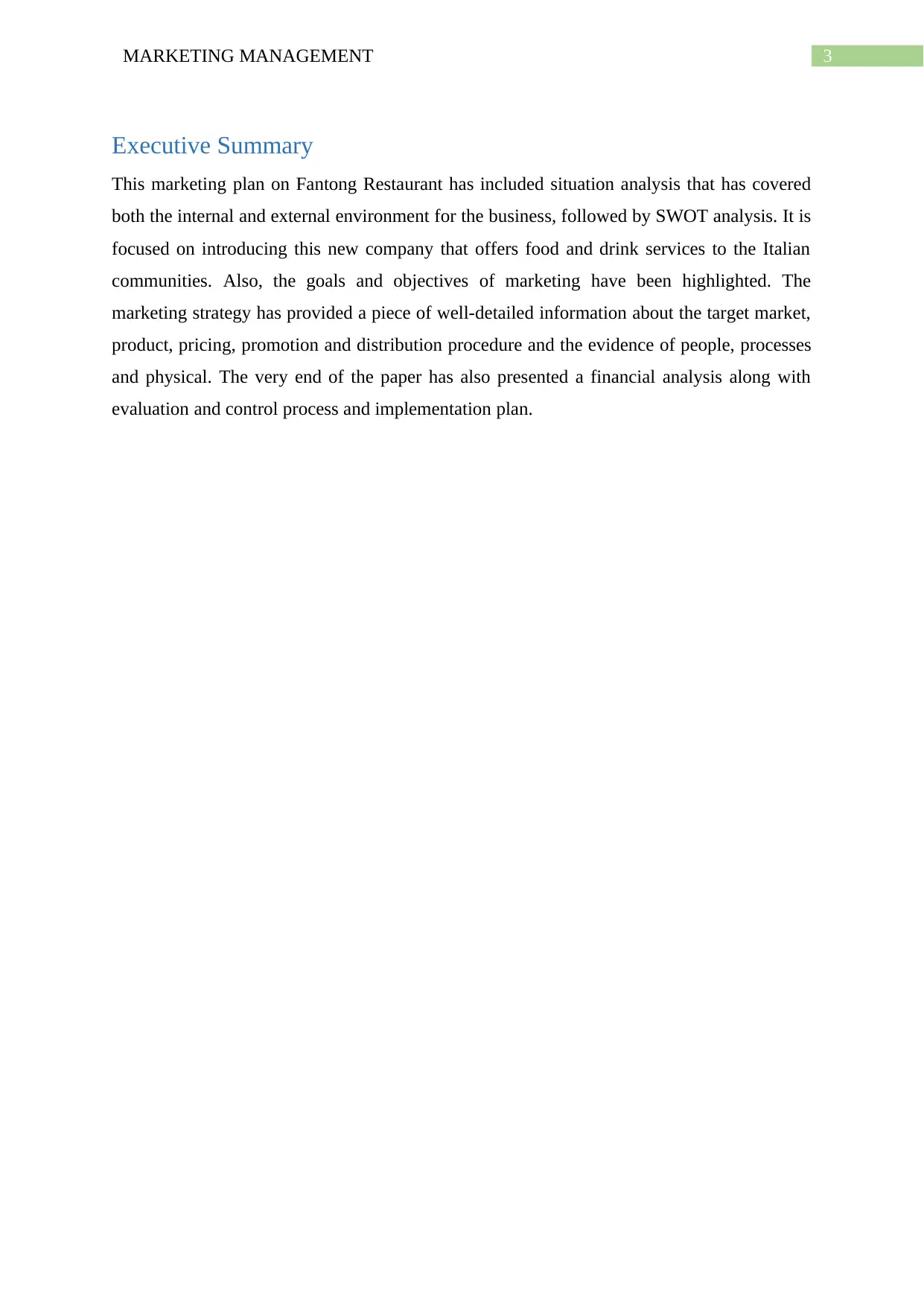
3MARKETING MANAGEMENT
Executive Summary
This marketing plan on Fantong Restaurant has included situation analysis that has covered
both the internal and external environment for the business, followed by SWOT analysis. It is
focused on introducing this new company that offers food and drink services to the Italian
communities. Also, the goals and objectives of marketing have been highlighted. The
marketing strategy has provided a piece of well-detailed information about the target market,
product, pricing, promotion and distribution procedure and the evidence of people, processes
and physical. The very end of the paper has also presented a financial analysis along with
evaluation and control process and implementation plan.
Executive Summary
This marketing plan on Fantong Restaurant has included situation analysis that has covered
both the internal and external environment for the business, followed by SWOT analysis. It is
focused on introducing this new company that offers food and drink services to the Italian
communities. Also, the goals and objectives of marketing have been highlighted. The
marketing strategy has provided a piece of well-detailed information about the target market,
product, pricing, promotion and distribution procedure and the evidence of people, processes
and physical. The very end of the paper has also presented a financial analysis along with
evaluation and control process and implementation plan.
Paraphrase This Document
Need a fresh take? Get an instant paraphrase of this document with our AI Paraphraser
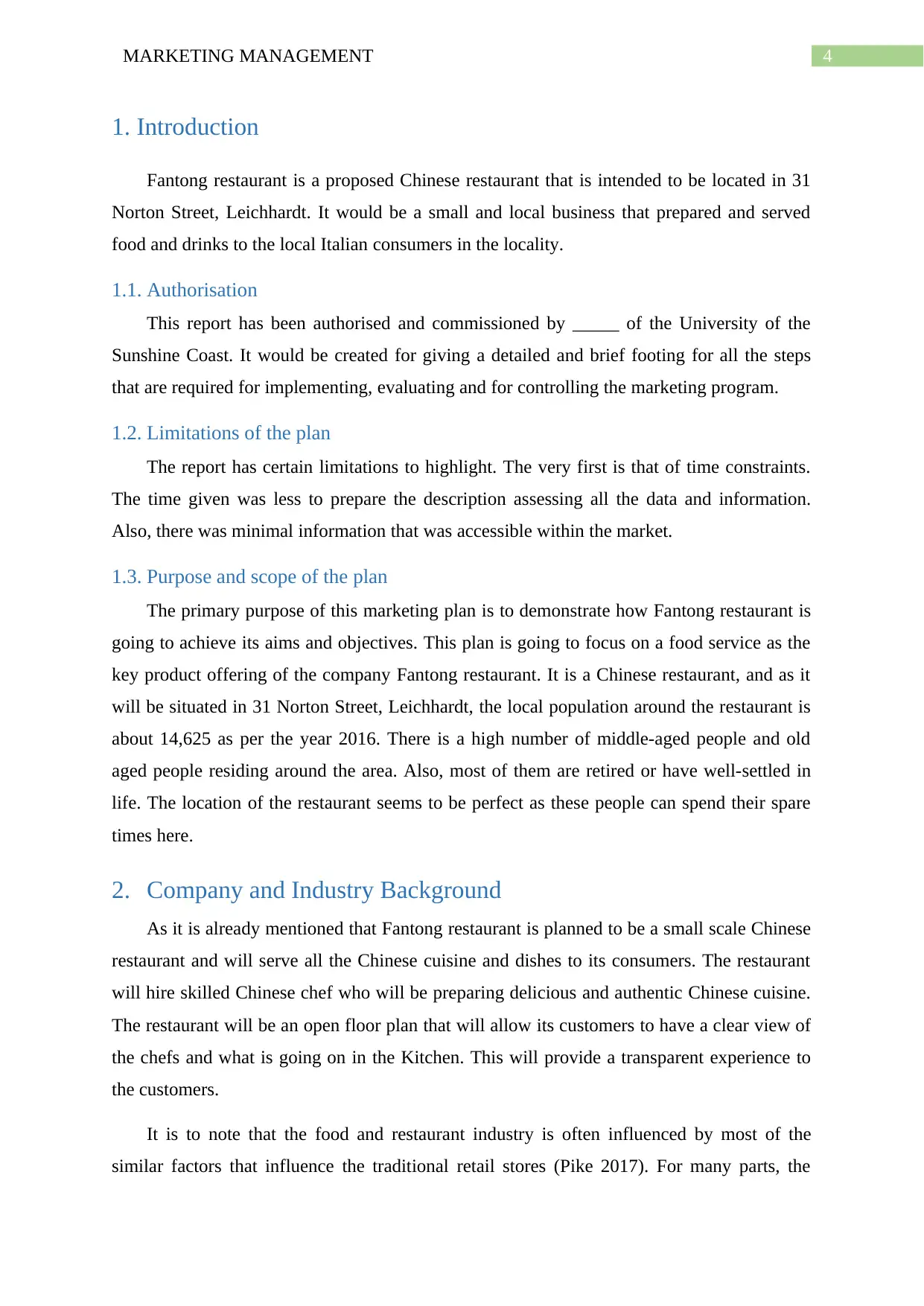
4MARKETING MANAGEMENT
1. Introduction
Fantong restaurant is a proposed Chinese restaurant that is intended to be located in 31
Norton Street, Leichhardt. It would be a small and local business that prepared and served
food and drinks to the local Italian consumers in the locality.
1.1. Authorisation
This report has been authorised and commissioned by _____ of the University of the
Sunshine Coast. It would be created for giving a detailed and brief footing for all the steps
that are required for implementing, evaluating and for controlling the marketing program.
1.2. Limitations of the plan
The report has certain limitations to highlight. The very first is that of time constraints.
The time given was less to prepare the description assessing all the data and information.
Also, there was minimal information that was accessible within the market.
1.3. Purpose and scope of the plan
The primary purpose of this marketing plan is to demonstrate how Fantong restaurant is
going to achieve its aims and objectives. This plan is going to focus on a food service as the
key product offering of the company Fantong restaurant. It is a Chinese restaurant, and as it
will be situated in 31 Norton Street, Leichhardt, the local population around the restaurant is
about 14,625 as per the year 2016. There is a high number of middle-aged people and old
aged people residing around the area. Also, most of them are retired or have well-settled in
life. The location of the restaurant seems to be perfect as these people can spend their spare
times here.
2. Company and Industry Background
As it is already mentioned that Fantong restaurant is planned to be a small scale Chinese
restaurant and will serve all the Chinese cuisine and dishes to its consumers. The restaurant
will hire skilled Chinese chef who will be preparing delicious and authentic Chinese cuisine.
The restaurant will be an open floor plan that will allow its customers to have a clear view of
the chefs and what is going on in the Kitchen. This will provide a transparent experience to
the customers.
It is to note that the food and restaurant industry is often influenced by most of the
similar factors that influence the traditional retail stores (Pike 2017). For many parts, the
1. Introduction
Fantong restaurant is a proposed Chinese restaurant that is intended to be located in 31
Norton Street, Leichhardt. It would be a small and local business that prepared and served
food and drinks to the local Italian consumers in the locality.
1.1. Authorisation
This report has been authorised and commissioned by _____ of the University of the
Sunshine Coast. It would be created for giving a detailed and brief footing for all the steps
that are required for implementing, evaluating and for controlling the marketing program.
1.2. Limitations of the plan
The report has certain limitations to highlight. The very first is that of time constraints.
The time given was less to prepare the description assessing all the data and information.
Also, there was minimal information that was accessible within the market.
1.3. Purpose and scope of the plan
The primary purpose of this marketing plan is to demonstrate how Fantong restaurant is
going to achieve its aims and objectives. This plan is going to focus on a food service as the
key product offering of the company Fantong restaurant. It is a Chinese restaurant, and as it
will be situated in 31 Norton Street, Leichhardt, the local population around the restaurant is
about 14,625 as per the year 2016. There is a high number of middle-aged people and old
aged people residing around the area. Also, most of them are retired or have well-settled in
life. The location of the restaurant seems to be perfect as these people can spend their spare
times here.
2. Company and Industry Background
As it is already mentioned that Fantong restaurant is planned to be a small scale Chinese
restaurant and will serve all the Chinese cuisine and dishes to its consumers. The restaurant
will hire skilled Chinese chef who will be preparing delicious and authentic Chinese cuisine.
The restaurant will be an open floor plan that will allow its customers to have a clear view of
the chefs and what is going on in the Kitchen. This will provide a transparent experience to
the customers.
It is to note that the food and restaurant industry is often influenced by most of the
similar factors that influence the traditional retail stores (Pike 2017). For many parts, the
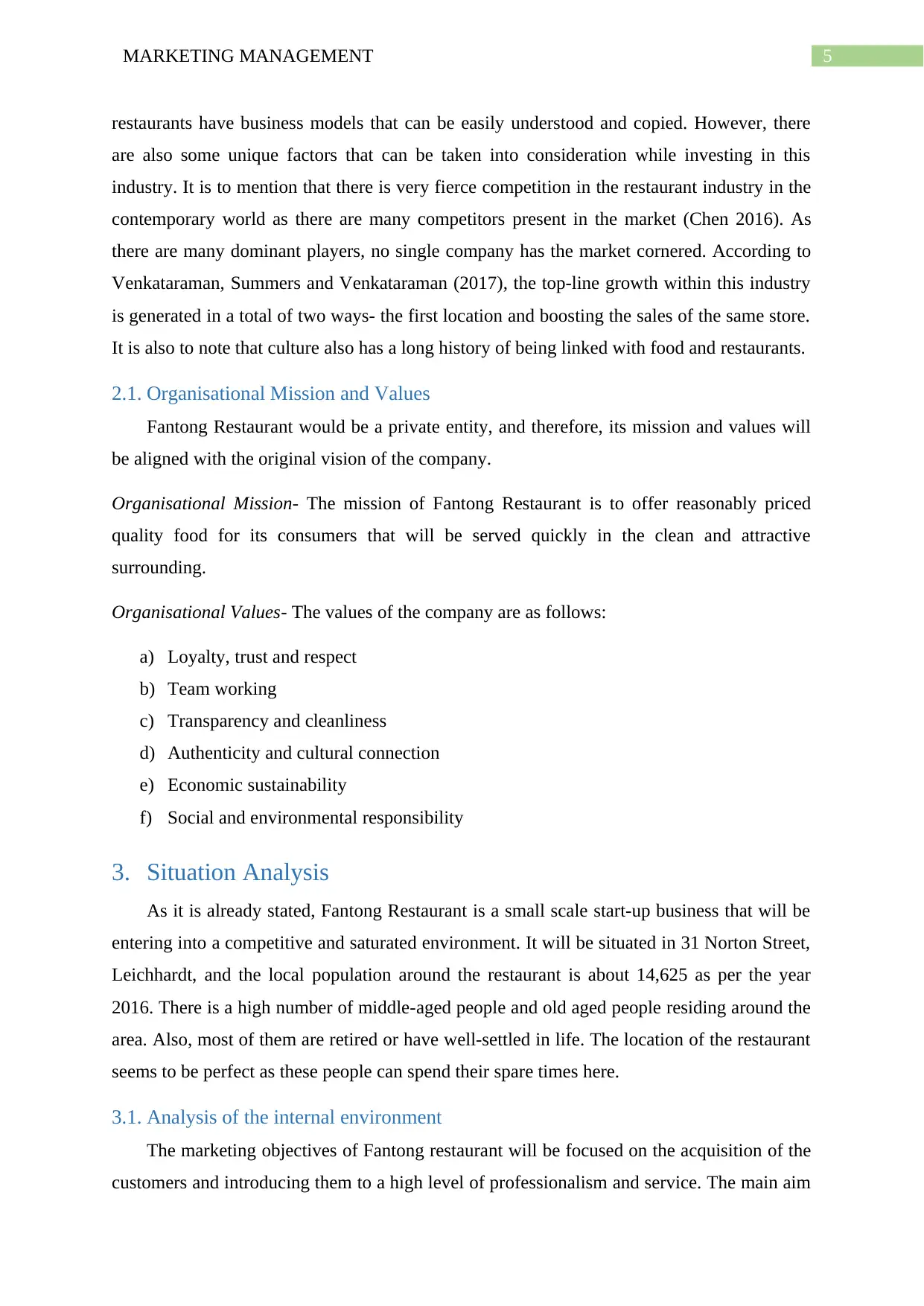
5MARKETING MANAGEMENT
restaurants have business models that can be easily understood and copied. However, there
are also some unique factors that can be taken into consideration while investing in this
industry. It is to mention that there is very fierce competition in the restaurant industry in the
contemporary world as there are many competitors present in the market (Chen 2016). As
there are many dominant players, no single company has the market cornered. According to
Venkataraman, Summers and Venkataraman (2017), the top-line growth within this industry
is generated in a total of two ways- the first location and boosting the sales of the same store.
It is also to note that culture also has a long history of being linked with food and restaurants.
2.1. Organisational Mission and Values
Fantong Restaurant would be a private entity, and therefore, its mission and values will
be aligned with the original vision of the company.
Organisational Mission- The mission of Fantong Restaurant is to offer reasonably priced
quality food for its consumers that will be served quickly in the clean and attractive
surrounding.
Organisational Values- The values of the company are as follows:
a) Loyalty, trust and respect
b) Team working
c) Transparency and cleanliness
d) Authenticity and cultural connection
e) Economic sustainability
f) Social and environmental responsibility
3. Situation Analysis
As it is already stated, Fantong Restaurant is a small scale start-up business that will be
entering into a competitive and saturated environment. It will be situated in 31 Norton Street,
Leichhardt, and the local population around the restaurant is about 14,625 as per the year
2016. There is a high number of middle-aged people and old aged people residing around the
area. Also, most of them are retired or have well-settled in life. The location of the restaurant
seems to be perfect as these people can spend their spare times here.
3.1. Analysis of the internal environment
The marketing objectives of Fantong restaurant will be focused on the acquisition of the
customers and introducing them to a high level of professionalism and service. The main aim
restaurants have business models that can be easily understood and copied. However, there
are also some unique factors that can be taken into consideration while investing in this
industry. It is to mention that there is very fierce competition in the restaurant industry in the
contemporary world as there are many competitors present in the market (Chen 2016). As
there are many dominant players, no single company has the market cornered. According to
Venkataraman, Summers and Venkataraman (2017), the top-line growth within this industry
is generated in a total of two ways- the first location and boosting the sales of the same store.
It is also to note that culture also has a long history of being linked with food and restaurants.
2.1. Organisational Mission and Values
Fantong Restaurant would be a private entity, and therefore, its mission and values will
be aligned with the original vision of the company.
Organisational Mission- The mission of Fantong Restaurant is to offer reasonably priced
quality food for its consumers that will be served quickly in the clean and attractive
surrounding.
Organisational Values- The values of the company are as follows:
a) Loyalty, trust and respect
b) Team working
c) Transparency and cleanliness
d) Authenticity and cultural connection
e) Economic sustainability
f) Social and environmental responsibility
3. Situation Analysis
As it is already stated, Fantong Restaurant is a small scale start-up business that will be
entering into a competitive and saturated environment. It will be situated in 31 Norton Street,
Leichhardt, and the local population around the restaurant is about 14,625 as per the year
2016. There is a high number of middle-aged people and old aged people residing around the
area. Also, most of them are retired or have well-settled in life. The location of the restaurant
seems to be perfect as these people can spend their spare times here.
3.1. Analysis of the internal environment
The marketing objectives of Fantong restaurant will be focused on the acquisition of the
customers and introducing them to a high level of professionalism and service. The main aim
⊘ This is a preview!⊘
Do you want full access?
Subscribe today to unlock all pages.

Trusted by 1+ million students worldwide
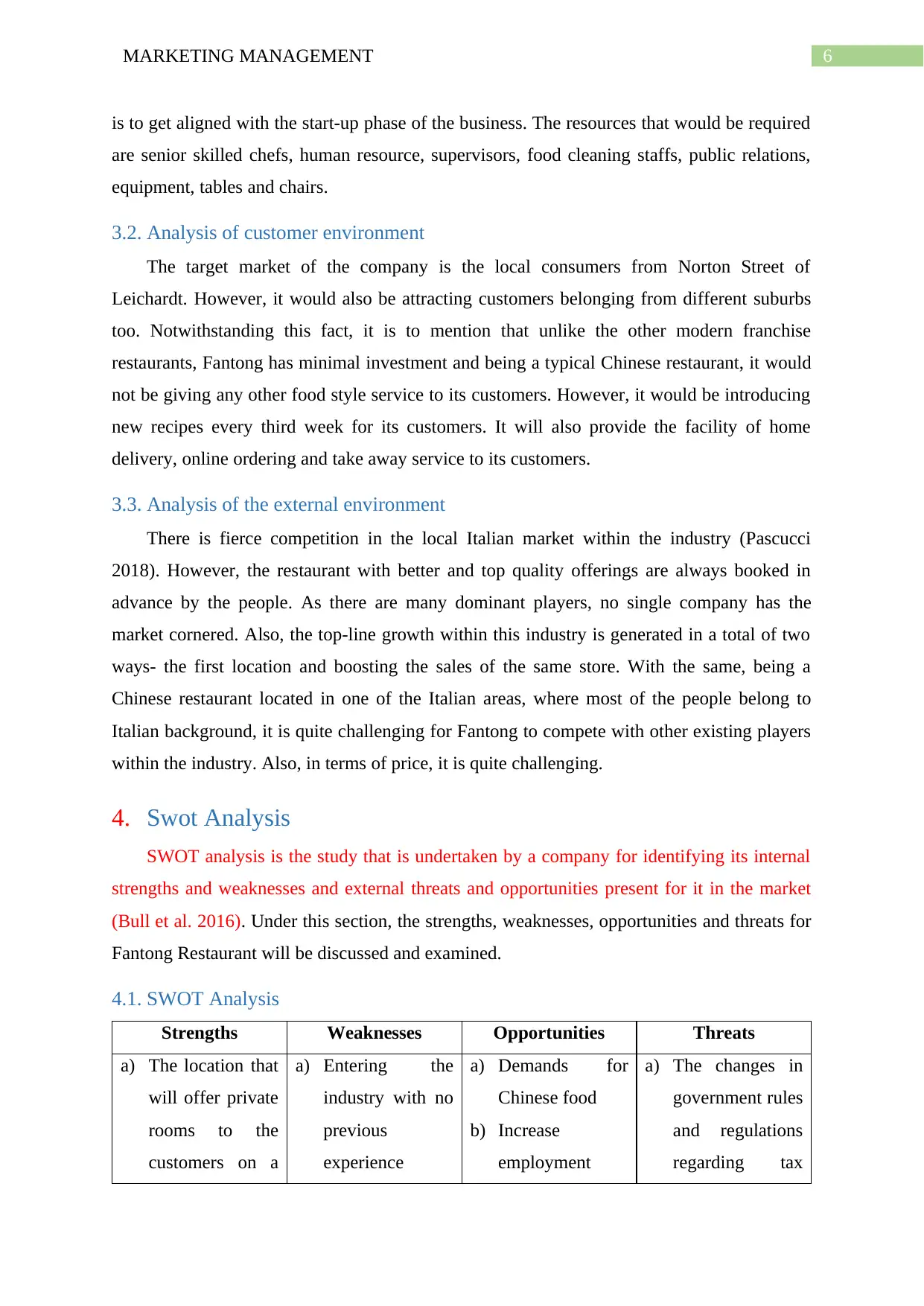
6MARKETING MANAGEMENT
is to get aligned with the start-up phase of the business. The resources that would be required
are senior skilled chefs, human resource, supervisors, food cleaning staffs, public relations,
equipment, tables and chairs.
3.2. Analysis of customer environment
The target market of the company is the local consumers from Norton Street of
Leichardt. However, it would also be attracting customers belonging from different suburbs
too. Notwithstanding this fact, it is to mention that unlike the other modern franchise
restaurants, Fantong has minimal investment and being a typical Chinese restaurant, it would
not be giving any other food style service to its customers. However, it would be introducing
new recipes every third week for its customers. It will also provide the facility of home
delivery, online ordering and take away service to its customers.
3.3. Analysis of the external environment
There is fierce competition in the local Italian market within the industry (Pascucci
2018). However, the restaurant with better and top quality offerings are always booked in
advance by the people. As there are many dominant players, no single company has the
market cornered. Also, the top-line growth within this industry is generated in a total of two
ways- the first location and boosting the sales of the same store. With the same, being a
Chinese restaurant located in one of the Italian areas, where most of the people belong to
Italian background, it is quite challenging for Fantong to compete with other existing players
within the industry. Also, in terms of price, it is quite challenging.
4. Swot Analysis
SWOT analysis is the study that is undertaken by a company for identifying its internal
strengths and weaknesses and external threats and opportunities present for it in the market
(Bull et al. 2016). Under this section, the strengths, weaknesses, opportunities and threats for
Fantong Restaurant will be discussed and examined.
4.1. SWOT Analysis
Strengths Weaknesses Opportunities Threats
a) The location that
will offer private
rooms to the
customers on a
a) Entering the
industry with no
previous
experience
a) Demands for
Chinese food
b) Increase
employment
a) The changes in
government rules
and regulations
regarding tax
is to get aligned with the start-up phase of the business. The resources that would be required
are senior skilled chefs, human resource, supervisors, food cleaning staffs, public relations,
equipment, tables and chairs.
3.2. Analysis of customer environment
The target market of the company is the local consumers from Norton Street of
Leichardt. However, it would also be attracting customers belonging from different suburbs
too. Notwithstanding this fact, it is to mention that unlike the other modern franchise
restaurants, Fantong has minimal investment and being a typical Chinese restaurant, it would
not be giving any other food style service to its customers. However, it would be introducing
new recipes every third week for its customers. It will also provide the facility of home
delivery, online ordering and take away service to its customers.
3.3. Analysis of the external environment
There is fierce competition in the local Italian market within the industry (Pascucci
2018). However, the restaurant with better and top quality offerings are always booked in
advance by the people. As there are many dominant players, no single company has the
market cornered. Also, the top-line growth within this industry is generated in a total of two
ways- the first location and boosting the sales of the same store. With the same, being a
Chinese restaurant located in one of the Italian areas, where most of the people belong to
Italian background, it is quite challenging for Fantong to compete with other existing players
within the industry. Also, in terms of price, it is quite challenging.
4. Swot Analysis
SWOT analysis is the study that is undertaken by a company for identifying its internal
strengths and weaknesses and external threats and opportunities present for it in the market
(Bull et al. 2016). Under this section, the strengths, weaknesses, opportunities and threats for
Fantong Restaurant will be discussed and examined.
4.1. SWOT Analysis
Strengths Weaknesses Opportunities Threats
a) The location that
will offer private
rooms to the
customers on a
a) Entering the
industry with no
previous
experience
a) Demands for
Chinese food
b) Increase
employment
a) The changes in
government rules
and regulations
regarding tax
Paraphrase This Document
Need a fresh take? Get an instant paraphrase of this document with our AI Paraphraser
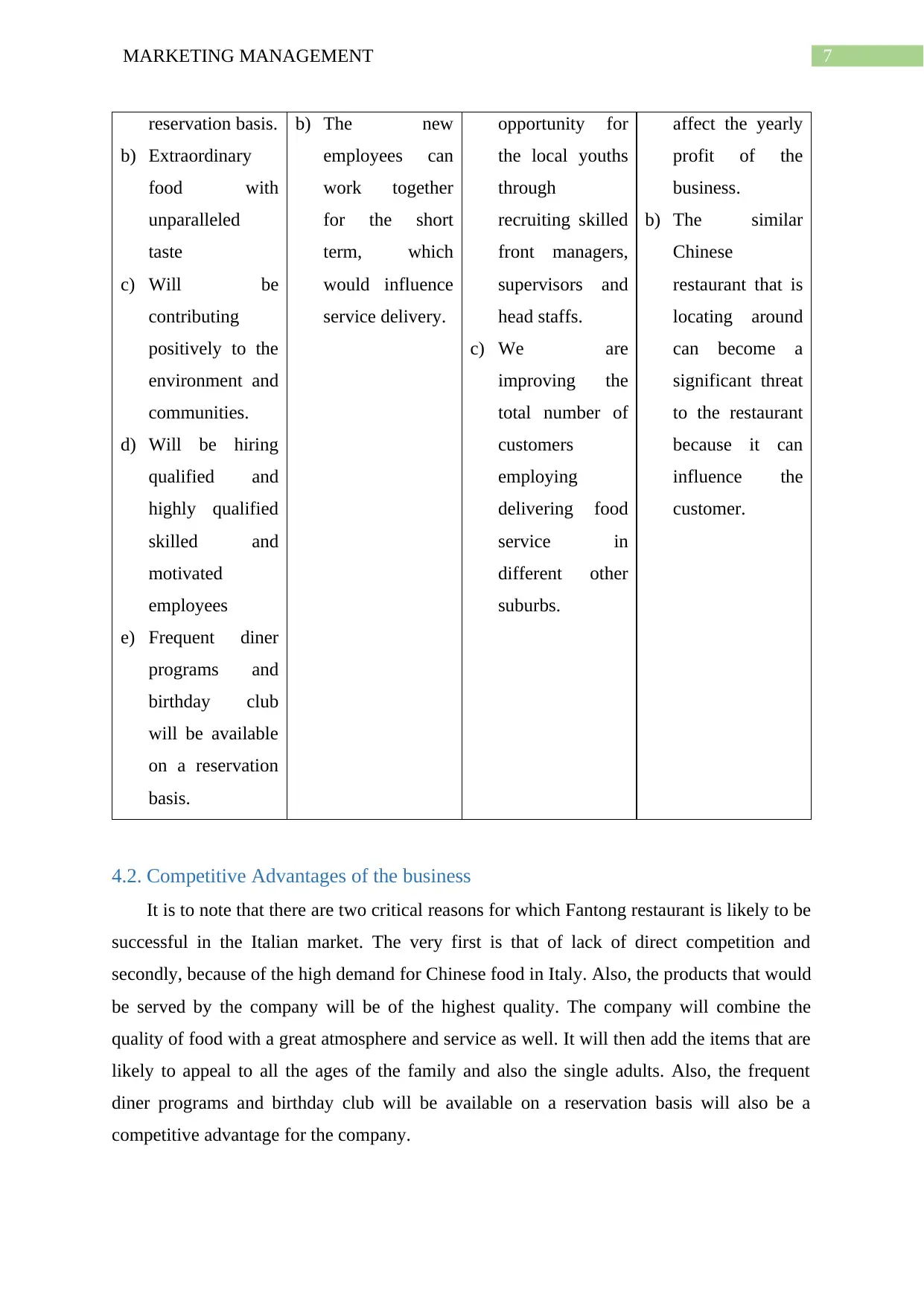
7MARKETING MANAGEMENT
reservation basis.
b) Extraordinary
food with
unparalleled
taste
c) Will be
contributing
positively to the
environment and
communities.
d) Will be hiring
qualified and
highly qualified
skilled and
motivated
employees
e) Frequent diner
programs and
birthday club
will be available
on a reservation
basis.
b) The new
employees can
work together
for the short
term, which
would influence
service delivery.
opportunity for
the local youths
through
recruiting skilled
front managers,
supervisors and
head staffs.
c) We are
improving the
total number of
customers
employing
delivering food
service in
different other
suburbs.
affect the yearly
profit of the
business.
b) The similar
Chinese
restaurant that is
locating around
can become a
significant threat
to the restaurant
because it can
influence the
customer.
4.2. Competitive Advantages of the business
It is to note that there are two critical reasons for which Fantong restaurant is likely to be
successful in the Italian market. The very first is that of lack of direct competition and
secondly, because of the high demand for Chinese food in Italy. Also, the products that would
be served by the company will be of the highest quality. The company will combine the
quality of food with a great atmosphere and service as well. It will then add the items that are
likely to appeal to all the ages of the family and also the single adults. Also, the frequent
diner programs and birthday club will be available on a reservation basis will also be a
competitive advantage for the company.
reservation basis.
b) Extraordinary
food with
unparalleled
taste
c) Will be
contributing
positively to the
environment and
communities.
d) Will be hiring
qualified and
highly qualified
skilled and
motivated
employees
e) Frequent diner
programs and
birthday club
will be available
on a reservation
basis.
b) The new
employees can
work together
for the short
term, which
would influence
service delivery.
opportunity for
the local youths
through
recruiting skilled
front managers,
supervisors and
head staffs.
c) We are
improving the
total number of
customers
employing
delivering food
service in
different other
suburbs.
affect the yearly
profit of the
business.
b) The similar
Chinese
restaurant that is
locating around
can become a
significant threat
to the restaurant
because it can
influence the
customer.
4.2. Competitive Advantages of the business
It is to note that there are two critical reasons for which Fantong restaurant is likely to be
successful in the Italian market. The very first is that of lack of direct competition and
secondly, because of the high demand for Chinese food in Italy. Also, the products that would
be served by the company will be of the highest quality. The company will combine the
quality of food with a great atmosphere and service as well. It will then add the items that are
likely to appeal to all the ages of the family and also the single adults. Also, the frequent
diner programs and birthday club will be available on a reservation basis will also be a
competitive advantage for the company.
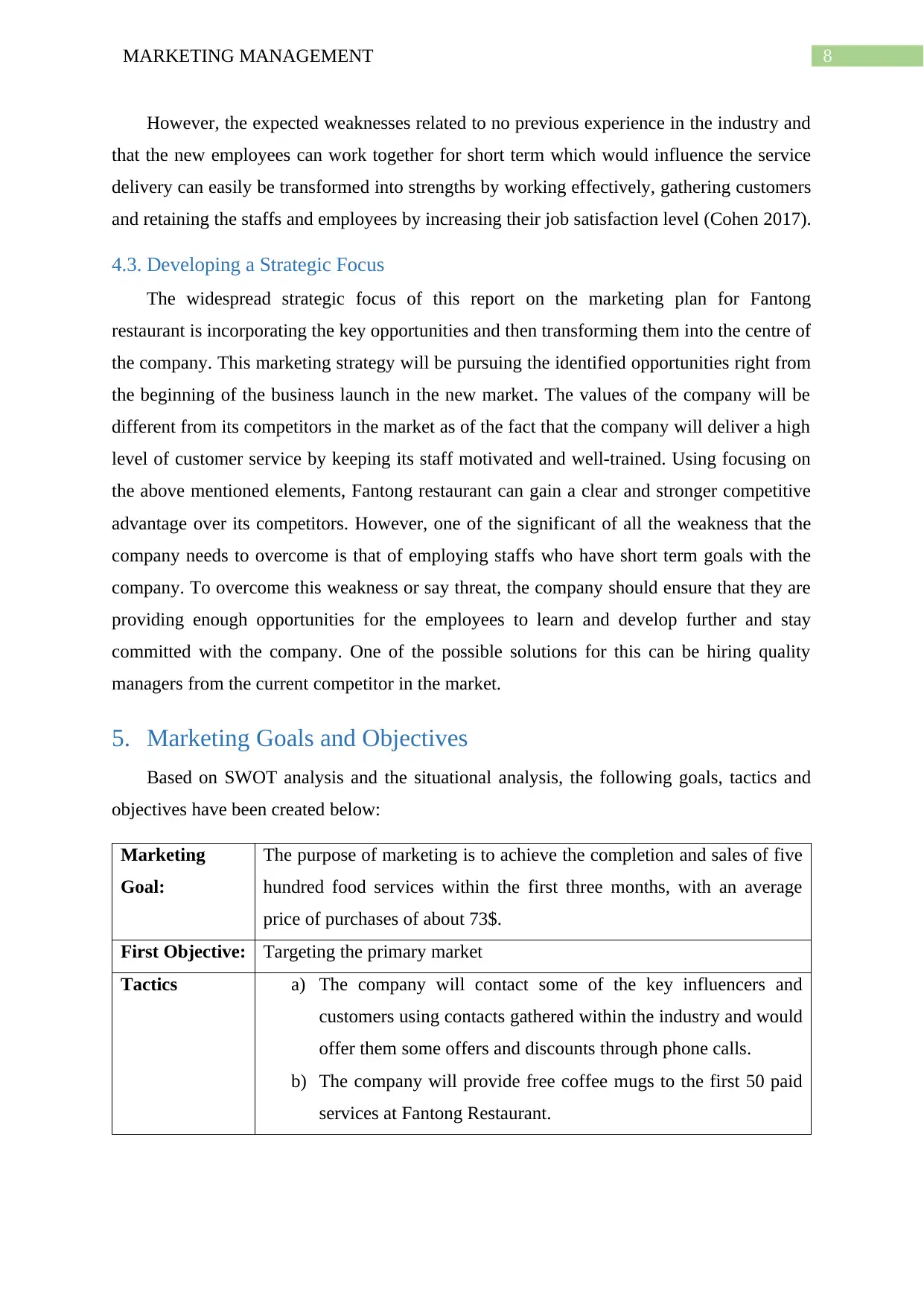
8MARKETING MANAGEMENT
However, the expected weaknesses related to no previous experience in the industry and
that the new employees can work together for short term which would influence the service
delivery can easily be transformed into strengths by working effectively, gathering customers
and retaining the staffs and employees by increasing their job satisfaction level (Cohen 2017).
4.3. Developing a Strategic Focus
The widespread strategic focus of this report on the marketing plan for Fantong
restaurant is incorporating the key opportunities and then transforming them into the centre of
the company. This marketing strategy will be pursuing the identified opportunities right from
the beginning of the business launch in the new market. The values of the company will be
different from its competitors in the market as of the fact that the company will deliver a high
level of customer service by keeping its staff motivated and well-trained. Using focusing on
the above mentioned elements, Fantong restaurant can gain a clear and stronger competitive
advantage over its competitors. However, one of the significant of all the weakness that the
company needs to overcome is that of employing staffs who have short term goals with the
company. To overcome this weakness or say threat, the company should ensure that they are
providing enough opportunities for the employees to learn and develop further and stay
committed with the company. One of the possible solutions for this can be hiring quality
managers from the current competitor in the market.
5. Marketing Goals and Objectives
Based on SWOT analysis and the situational analysis, the following goals, tactics and
objectives have been created below:
Marketing
Goal:
The purpose of marketing is to achieve the completion and sales of five
hundred food services within the first three months, with an average
price of purchases of about 73$.
First Objective: Targeting the primary market
Tactics a) The company will contact some of the key influencers and
customers using contacts gathered within the industry and would
offer them some offers and discounts through phone calls.
b) The company will provide free coffee mugs to the first 50 paid
services at Fantong Restaurant.
However, the expected weaknesses related to no previous experience in the industry and
that the new employees can work together for short term which would influence the service
delivery can easily be transformed into strengths by working effectively, gathering customers
and retaining the staffs and employees by increasing their job satisfaction level (Cohen 2017).
4.3. Developing a Strategic Focus
The widespread strategic focus of this report on the marketing plan for Fantong
restaurant is incorporating the key opportunities and then transforming them into the centre of
the company. This marketing strategy will be pursuing the identified opportunities right from
the beginning of the business launch in the new market. The values of the company will be
different from its competitors in the market as of the fact that the company will deliver a high
level of customer service by keeping its staff motivated and well-trained. Using focusing on
the above mentioned elements, Fantong restaurant can gain a clear and stronger competitive
advantage over its competitors. However, one of the significant of all the weakness that the
company needs to overcome is that of employing staffs who have short term goals with the
company. To overcome this weakness or say threat, the company should ensure that they are
providing enough opportunities for the employees to learn and develop further and stay
committed with the company. One of the possible solutions for this can be hiring quality
managers from the current competitor in the market.
5. Marketing Goals and Objectives
Based on SWOT analysis and the situational analysis, the following goals, tactics and
objectives have been created below:
Marketing
Goal:
The purpose of marketing is to achieve the completion and sales of five
hundred food services within the first three months, with an average
price of purchases of about 73$.
First Objective: Targeting the primary market
Tactics a) The company will contact some of the key influencers and
customers using contacts gathered within the industry and would
offer them some offers and discounts through phone calls.
b) The company will provide free coffee mugs to the first 50 paid
services at Fantong Restaurant.
⊘ This is a preview!⊘
Do you want full access?
Subscribe today to unlock all pages.

Trusted by 1+ million students worldwide
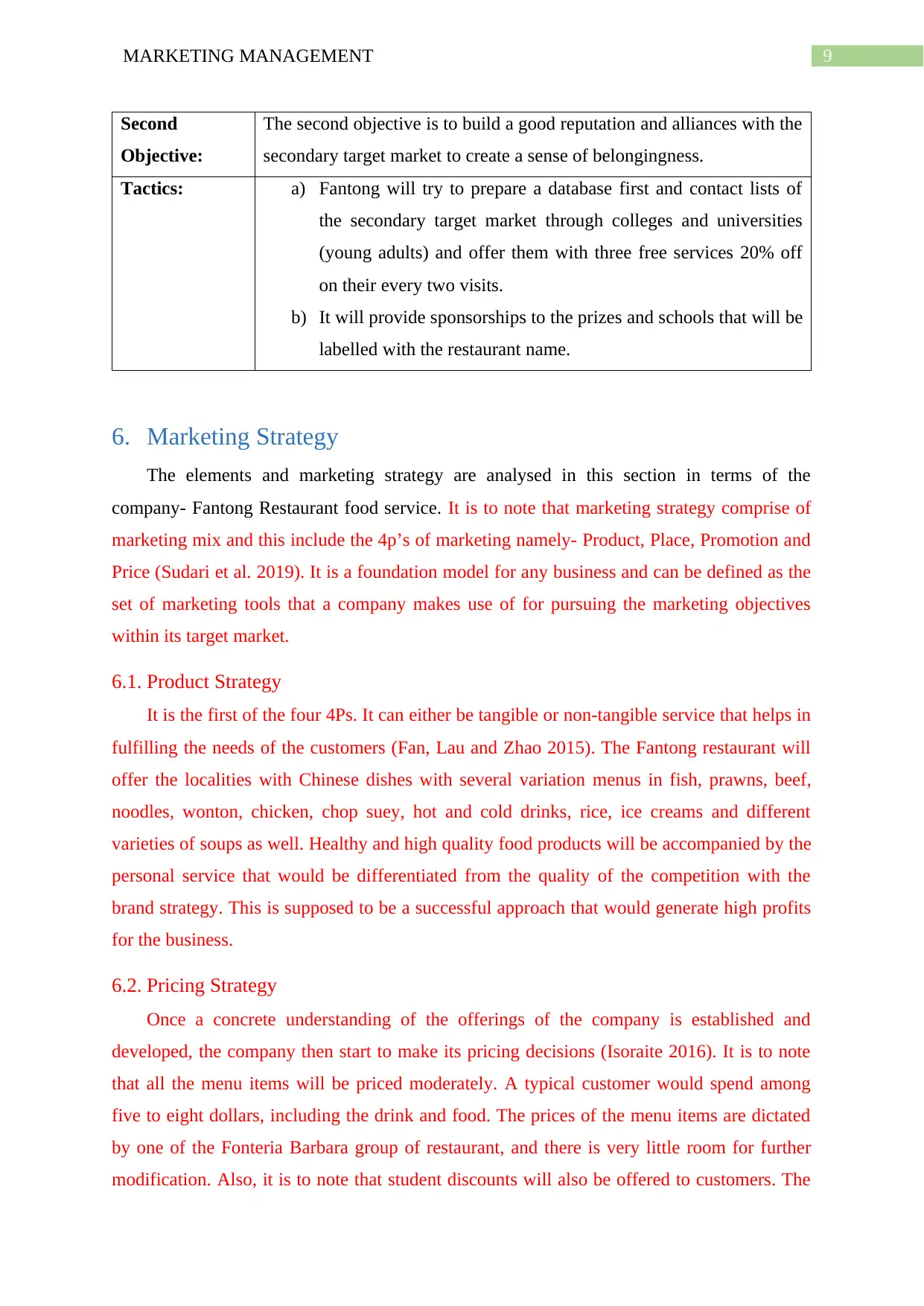
9MARKETING MANAGEMENT
Second
Objective:
The second objective is to build a good reputation and alliances with the
secondary target market to create a sense of belongingness.
Tactics: a) Fantong will try to prepare a database first and contact lists of
the secondary target market through colleges and universities
(young adults) and offer them with three free services 20% off
on their every two visits.
b) It will provide sponsorships to the prizes and schools that will be
labelled with the restaurant name.
6. Marketing Strategy
The elements and marketing strategy are analysed in this section in terms of the
company- Fantong Restaurant food service. It is to note that marketing strategy comprise of
marketing mix and this include the 4p’s of marketing namely- Product, Place, Promotion and
Price (Sudari et al. 2019). It is a foundation model for any business and can be defined as the
set of marketing tools that a company makes use of for pursuing the marketing objectives
within its target market.
6.1. Product Strategy
It is the first of the four 4Ps. It can either be tangible or non-tangible service that helps in
fulfilling the needs of the customers (Fan, Lau and Zhao 2015). The Fantong restaurant will
offer the localities with Chinese dishes with several variation menus in fish, prawns, beef,
noodles, wonton, chicken, chop suey, hot and cold drinks, rice, ice creams and different
varieties of soups as well. Healthy and high quality food products will be accompanied by the
personal service that would be differentiated from the quality of the competition with the
brand strategy. This is supposed to be a successful approach that would generate high profits
for the business.
6.2. Pricing Strategy
Once a concrete understanding of the offerings of the company is established and
developed, the company then start to make its pricing decisions (Isoraite 2016). It is to note
that all the menu items will be priced moderately. A typical customer would spend among
five to eight dollars, including the drink and food. The prices of the menu items are dictated
by one of the Fonteria Barbara group of restaurant, and there is very little room for further
modification. Also, it is to note that student discounts will also be offered to customers. The
Second
Objective:
The second objective is to build a good reputation and alliances with the
secondary target market to create a sense of belongingness.
Tactics: a) Fantong will try to prepare a database first and contact lists of
the secondary target market through colleges and universities
(young adults) and offer them with three free services 20% off
on their every two visits.
b) It will provide sponsorships to the prizes and schools that will be
labelled with the restaurant name.
6. Marketing Strategy
The elements and marketing strategy are analysed in this section in terms of the
company- Fantong Restaurant food service. It is to note that marketing strategy comprise of
marketing mix and this include the 4p’s of marketing namely- Product, Place, Promotion and
Price (Sudari et al. 2019). It is a foundation model for any business and can be defined as the
set of marketing tools that a company makes use of for pursuing the marketing objectives
within its target market.
6.1. Product Strategy
It is the first of the four 4Ps. It can either be tangible or non-tangible service that helps in
fulfilling the needs of the customers (Fan, Lau and Zhao 2015). The Fantong restaurant will
offer the localities with Chinese dishes with several variation menus in fish, prawns, beef,
noodles, wonton, chicken, chop suey, hot and cold drinks, rice, ice creams and different
varieties of soups as well. Healthy and high quality food products will be accompanied by the
personal service that would be differentiated from the quality of the competition with the
brand strategy. This is supposed to be a successful approach that would generate high profits
for the business.
6.2. Pricing Strategy
Once a concrete understanding of the offerings of the company is established and
developed, the company then start to make its pricing decisions (Isoraite 2016). It is to note
that all the menu items will be priced moderately. A typical customer would spend among
five to eight dollars, including the drink and food. The prices of the menu items are dictated
by one of the Fonteria Barbara group of restaurant, and there is very little room for further
modification. Also, it is to note that student discounts will also be offered to customers. The
Paraphrase This Document
Need a fresh take? Get an instant paraphrase of this document with our AI Paraphraser
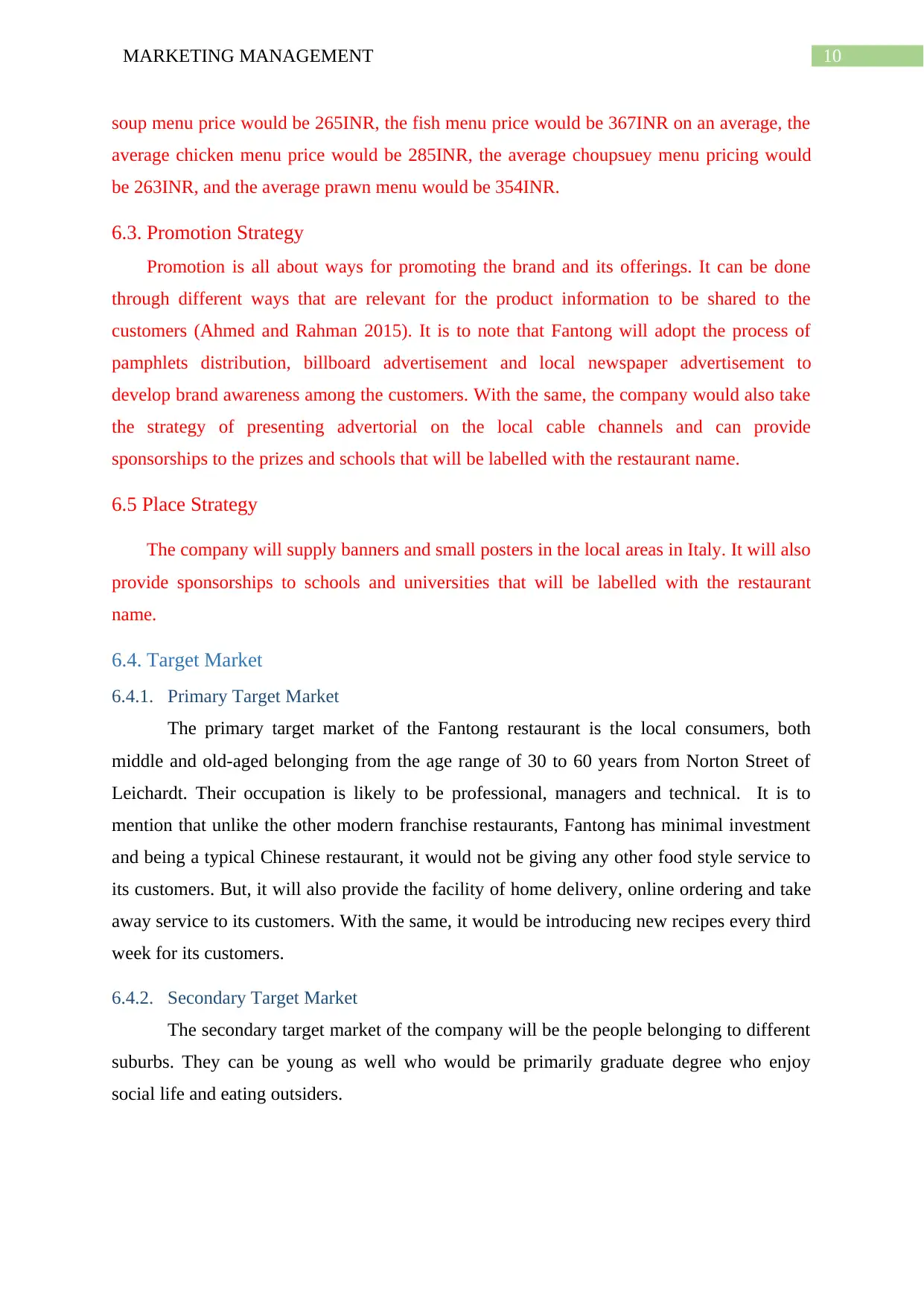
10MARKETING MANAGEMENT
soup menu price would be 265INR, the fish menu price would be 367INR on an average, the
average chicken menu price would be 285INR, the average choupsuey menu pricing would
be 263INR, and the average prawn menu would be 354INR.
6.3. Promotion Strategy
Promotion is all about ways for promoting the brand and its offerings. It can be done
through different ways that are relevant for the product information to be shared to the
customers (Ahmed and Rahman 2015). It is to note that Fantong will adopt the process of
pamphlets distribution, billboard advertisement and local newspaper advertisement to
develop brand awareness among the customers. With the same, the company would also take
the strategy of presenting advertorial on the local cable channels and can provide
sponsorships to the prizes and schools that will be labelled with the restaurant name.
6.5 Place Strategy
The company will supply banners and small posters in the local areas in Italy. It will also
provide sponsorships to schools and universities that will be labelled with the restaurant
name.
6.4. Target Market
6.4.1. Primary Target Market
The primary target market of the Fantong restaurant is the local consumers, both
middle and old-aged belonging from the age range of 30 to 60 years from Norton Street of
Leichardt. Their occupation is likely to be professional, managers and technical. It is to
mention that unlike the other modern franchise restaurants, Fantong has minimal investment
and being a typical Chinese restaurant, it would not be giving any other food style service to
its customers. But, it will also provide the facility of home delivery, online ordering and take
away service to its customers. With the same, it would be introducing new recipes every third
week for its customers.
6.4.2. Secondary Target Market
The secondary target market of the company will be the people belonging to different
suburbs. They can be young as well who would be primarily graduate degree who enjoy
social life and eating outsiders.
soup menu price would be 265INR, the fish menu price would be 367INR on an average, the
average chicken menu price would be 285INR, the average choupsuey menu pricing would
be 263INR, and the average prawn menu would be 354INR.
6.3. Promotion Strategy
Promotion is all about ways for promoting the brand and its offerings. It can be done
through different ways that are relevant for the product information to be shared to the
customers (Ahmed and Rahman 2015). It is to note that Fantong will adopt the process of
pamphlets distribution, billboard advertisement and local newspaper advertisement to
develop brand awareness among the customers. With the same, the company would also take
the strategy of presenting advertorial on the local cable channels and can provide
sponsorships to the prizes and schools that will be labelled with the restaurant name.
6.5 Place Strategy
The company will supply banners and small posters in the local areas in Italy. It will also
provide sponsorships to schools and universities that will be labelled with the restaurant
name.
6.4. Target Market
6.4.1. Primary Target Market
The primary target market of the Fantong restaurant is the local consumers, both
middle and old-aged belonging from the age range of 30 to 60 years from Norton Street of
Leichardt. Their occupation is likely to be professional, managers and technical. It is to
mention that unlike the other modern franchise restaurants, Fantong has minimal investment
and being a typical Chinese restaurant, it would not be giving any other food style service to
its customers. But, it will also provide the facility of home delivery, online ordering and take
away service to its customers. With the same, it would be introducing new recipes every third
week for its customers.
6.4.2. Secondary Target Market
The secondary target market of the company will be the people belonging to different
suburbs. They can be young as well who would be primarily graduate degree who enjoy
social life and eating outsiders.
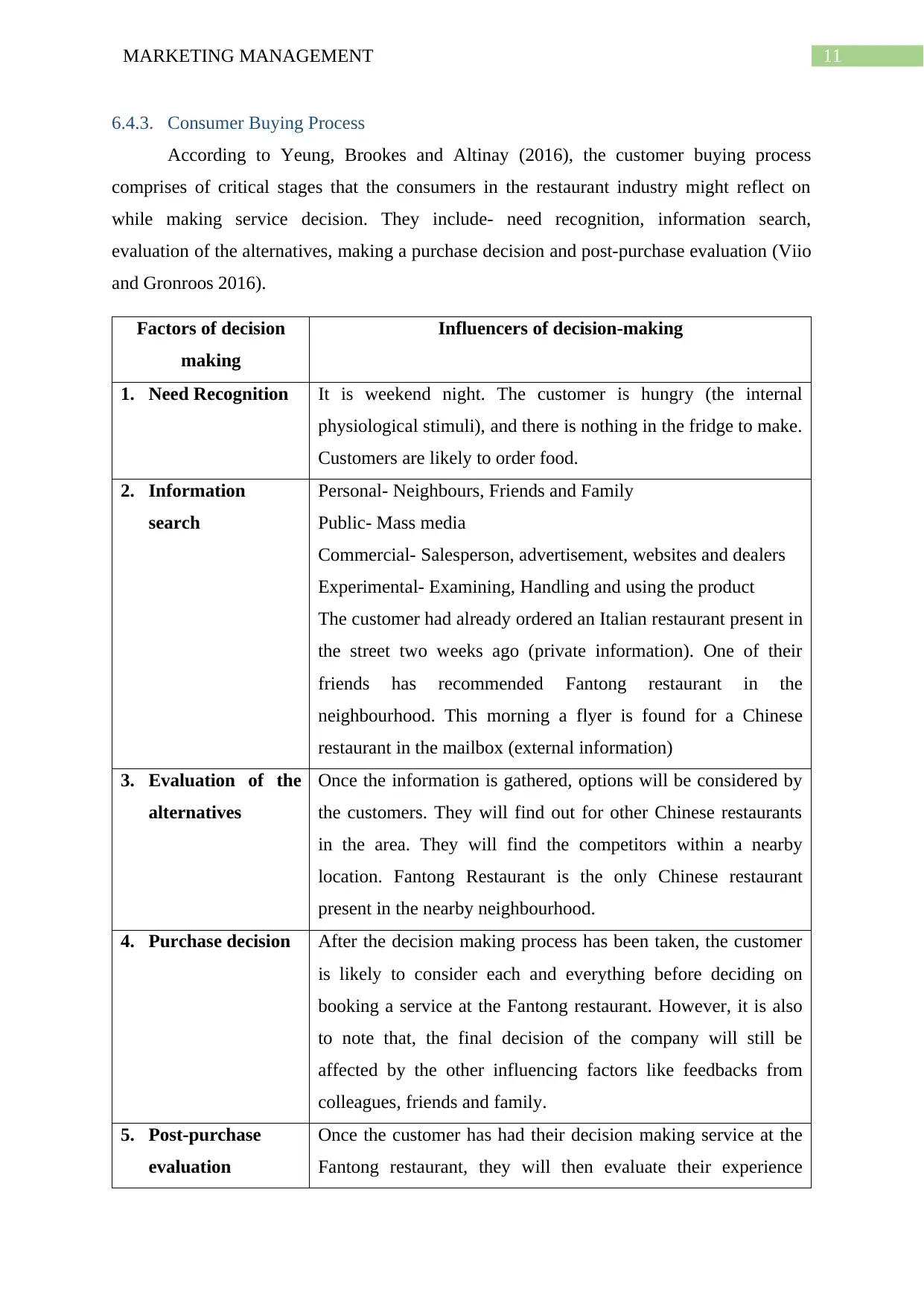
11MARKETING MANAGEMENT
6.4.3. Consumer Buying Process
According to Yeung, Brookes and Altinay (2016), the customer buying process
comprises of critical stages that the consumers in the restaurant industry might reflect on
while making service decision. They include- need recognition, information search,
evaluation of the alternatives, making a purchase decision and post-purchase evaluation (Viio
and Gronroos 2016).
Factors of decision
making
Influencers of decision-making
1. Need Recognition It is weekend night. The customer is hungry (the internal
physiological stimuli), and there is nothing in the fridge to make.
Customers are likely to order food.
2. Information
search
Personal- Neighbours, Friends and Family
Public- Mass media
Commercial- Salesperson, advertisement, websites and dealers
Experimental- Examining, Handling and using the product
The customer had already ordered an Italian restaurant present in
the street two weeks ago (private information). One of their
friends has recommended Fantong restaurant in the
neighbourhood. This morning a flyer is found for a Chinese
restaurant in the mailbox (external information)
3. Evaluation of the
alternatives
Once the information is gathered, options will be considered by
the customers. They will find out for other Chinese restaurants
in the area. They will find the competitors within a nearby
location. Fantong Restaurant is the only Chinese restaurant
present in the nearby neighbourhood.
4. Purchase decision After the decision making process has been taken, the customer
is likely to consider each and everything before deciding on
booking a service at the Fantong restaurant. However, it is also
to note that, the final decision of the company will still be
affected by the other influencing factors like feedbacks from
colleagues, friends and family.
5. Post-purchase
evaluation
Once the customer has had their decision making service at the
Fantong restaurant, they will then evaluate their experience
6.4.3. Consumer Buying Process
According to Yeung, Brookes and Altinay (2016), the customer buying process
comprises of critical stages that the consumers in the restaurant industry might reflect on
while making service decision. They include- need recognition, information search,
evaluation of the alternatives, making a purchase decision and post-purchase evaluation (Viio
and Gronroos 2016).
Factors of decision
making
Influencers of decision-making
1. Need Recognition It is weekend night. The customer is hungry (the internal
physiological stimuli), and there is nothing in the fridge to make.
Customers are likely to order food.
2. Information
search
Personal- Neighbours, Friends and Family
Public- Mass media
Commercial- Salesperson, advertisement, websites and dealers
Experimental- Examining, Handling and using the product
The customer had already ordered an Italian restaurant present in
the street two weeks ago (private information). One of their
friends has recommended Fantong restaurant in the
neighbourhood. This morning a flyer is found for a Chinese
restaurant in the mailbox (external information)
3. Evaluation of the
alternatives
Once the information is gathered, options will be considered by
the customers. They will find out for other Chinese restaurants
in the area. They will find the competitors within a nearby
location. Fantong Restaurant is the only Chinese restaurant
present in the nearby neighbourhood.
4. Purchase decision After the decision making process has been taken, the customer
is likely to consider each and everything before deciding on
booking a service at the Fantong restaurant. However, it is also
to note that, the final decision of the company will still be
affected by the other influencing factors like feedbacks from
colleagues, friends and family.
5. Post-purchase
evaluation
Once the customer has had their decision making service at the
Fantong restaurant, they will then evaluate their experience
⊘ This is a preview!⊘
Do you want full access?
Subscribe today to unlock all pages.

Trusted by 1+ million students worldwide
1 out of 21
Related Documents
Your All-in-One AI-Powered Toolkit for Academic Success.
+13062052269
info@desklib.com
Available 24*7 on WhatsApp / Email
![[object Object]](/_next/static/media/star-bottom.7253800d.svg)
Unlock your academic potential
Copyright © 2020–2025 A2Z Services. All Rights Reserved. Developed and managed by ZUCOL.





